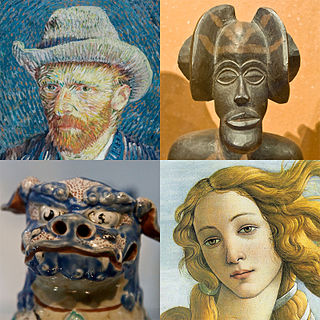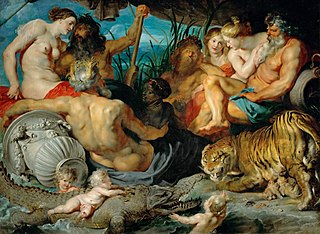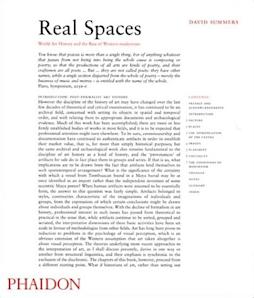Related Research Articles

Art is a diverse range of human activity, and resulting product, that involves creative or imaginative talent expressive of technical proficiency, beauty, emotional power, or conceptual ideas.

Aesthetics, is a branch of philosophy that deals with the nature of beauty and taste, as well as the philosophy of art. It examines aesthetic values, often expressed through judgments of taste.
Iconology is a method of interpretation in cultural history and the history of the visual arts used by Aby Warburg, Erwin Panofsky and their followers that uncovers the cultural, social, and historical background of themes and subjects in the visual arts. Though Panofsky differentiated between iconology and iconography, the distinction is not very widely followed, "and they have never been given definitions accepted by all iconographers and iconologists". Few 21st-century authors continue to use the term "iconology" consistently, and instead use iconography to cover both areas of scholarship.

In the arts and in literature, the term avant-garde identifies a genre of art, an experimental work of art, and the experimental artist who created the work of art, which usually is aesthetically innovative, whilst initially being ideologically unacceptable to the artistic establishment of the time. The military metaphor of an advance guard identifies the artists and writers whose innovations in style, form, and subject-matter challenge the artistic and aesthetic validity of the established forms of art and the literary traditions of their time; thus how the artists who created the anti-novel and Surrealism were ahead of their times.

Installation art is an artistic genre of three-dimensional works that are often site-specific and designed to transform the perception of a space. Generally, the term is applied to interior spaces, whereas exterior interventions are often called public art, land art or art intervention; however, the boundaries between these terms overlap.

Postmodern art is a body of art movements that sought to contradict some aspects of modernism or some aspects that emerged or developed in its aftermath. In general, movements such as intermedia, installation art, conceptual art and multimedia, particularly involving video are described as postmodern.
Postminimalism is an art term coined by Robert Pincus-Witten in 1971 and used in various artistic fields for work which is influenced by, or attempts to develop and go beyond, the aesthetic of minimalism. The expression is used specifically in relation to music and the visual arts, but can refer to any field using minimalism as a critical reference point. In music, "postminimalism" refers to music following minimal music.

Against Interpretation is a 1966 collection of essays by Susan Sontag. It includes some of Sontag's best-known works, including "On Style," and the eponymous essay "Against Interpretation." In the latter, Sontag argues that the new approach to criticism and aesthetics neglects the sensuous impact and novelty of art, instead fitting works into predetermined intellectual interpretations and emphasis on the "content" or "meaning" of a work. The book was a finalist for the Arts and Letters category of the National Book Award.

Anti-art is a loosely used term applied to an array of concepts and attitudes that reject prior definitions of art and question art in general. Somewhat paradoxically, anti-art tends to conduct this questioning and rejection from the vantage point of art. The term is associated with the Dada movement and is generally accepted as attributable to Marcel Duchamp pre-World War I around 1914, when he began to use found objects as art. It was used to describe revolutionary forms of art. The term was used later by the Conceptual artists of the 1960s to describe the work of those who claimed to have retired altogether from the practice of art, from the production of works which could be sold.
Metarealism is a direction in Russian poetry and art that was born in the 1970s to the 1980s. The term was first used by Mikhail Epshtein, who coined it in 1981 and made it public in the Soviet magazine "Voprosy Literatury" in 1983

A work of art, artwork, art piece, piece of art or art object is an artistic creation of aesthetic value. Except for "work of art", which may be used of any work regarded as art in its widest sense, including works from literature and music, these terms apply principally to tangible, physical forms of visual art:
Frame analysis is a multi-disciplinary social science research method used to analyze how people understand situations and activities. Frame analysis looks at images, stereotypes, metaphors, actors, messages, and more. It examines how important these factors are and how and why they are chosen. The concept is generally attributed to the work of Erving Goffman and his 1974 book Frame analysis: An essay on the organization of experience and has been developed in social movement theory, policy studies and elsewhere.

Art historians and philosophers of art have long had classificatory disputes about art regarding whether a particular cultural form or piece of work should be classified as art. Disputes about what does and does not count as art continue to occur today.
The conservation and restoration of new media art is the study and practice of techniques for sustaining new media art created using from materials such as digital, biological, performative, and other variable media.
In the visual arts, late modernism encompasses the overall production of most recent art made between the aftermath of World War II and the early years of the 21st century. The terminology often points to similarities between late modernism and post-modernism although there are differences. The predominant term for art produced since the 1950s is contemporary art. Not all art labelled as contemporary art is modernist or post-modern, and the broader term encompasses both artists who continue to work in modern and late modernist traditions, as well as artists who reject modernism for post-modernism or other reasons. Arthur Danto argues explicitly in After the End of Art that contemporaneity was the broader term, and that postmodern objects represent a subsector of the contemporary movement which replaced modernity and modernism, while other notable critics: Hilton Kramer, Robert C. Morgan, Kirk Varnedoe, Jean-François Lyotard and others have argued that postmodern objects are at best relative to modernist works.

Real Spaces: World Art History and the Rise of Western Modernism is a non-fiction book by art historian David Summers, who aims to reconcile Western art history to artistic cultural production around the world from all time periods.
The performative turn is a paradigmatic shift in the humanities and social sciences that has affected such disciplines as anthropology, archaeology, linguistics, ethnography, history and the relatively young discipline of performance studies. Central to the performative turn is the concept of performance.

The arts are a very wide range of human practices of creative expression, storytelling and cultural participation. They encompass multiple diverse and plural modes of thinking, doing and being, in an extremely broad range of media. Both highly dynamic and a characteristically constant feature of human life, they have developed into innovative, stylized and sometimes intricate forms. This is often achieved through sustained and deliberate study, training and/or theorizing within a particular tradition, across generations and even between civilizations. The arts are a vehicle through which human beings cultivate distinct social, cultural and individual identities, while transmitting values, impressions, judgments, ideas, visions, spiritual meanings, patterns of life and experiences across time and space.
The Shanghai Biennale is one of the highest-profile contemporary art events in Shanghai and the most established art biennale in China. It was initially held in the Shanghai Art Museum. From 2012 on, it has been hosted in Power Station of Art, the first state-run museum dedicated to contemporary art in mainland China. Shanghai Biennale provides artists, curators, writers and art supporters from around the world with a space to meet and exchange ideas about their experiences, works and inspirations to create international dialogues. It highlights the achievements of Asian artistic creativity and production and challenges the conventional division of the world between East and West. Aside from its main museum show, it also includes talks, lectures and installations in various venues throughout the city.
In linguistics, psychology, and literary theory, the concepts of deictic field and deictic shift are sometimes deployed in the study of narrative media. These terms provide a theoretical framework for helping literary analysts to conceptualize the ways in which readers redirect their attention away from their immediate surroundings as they become immersed in the reality generated by the text.